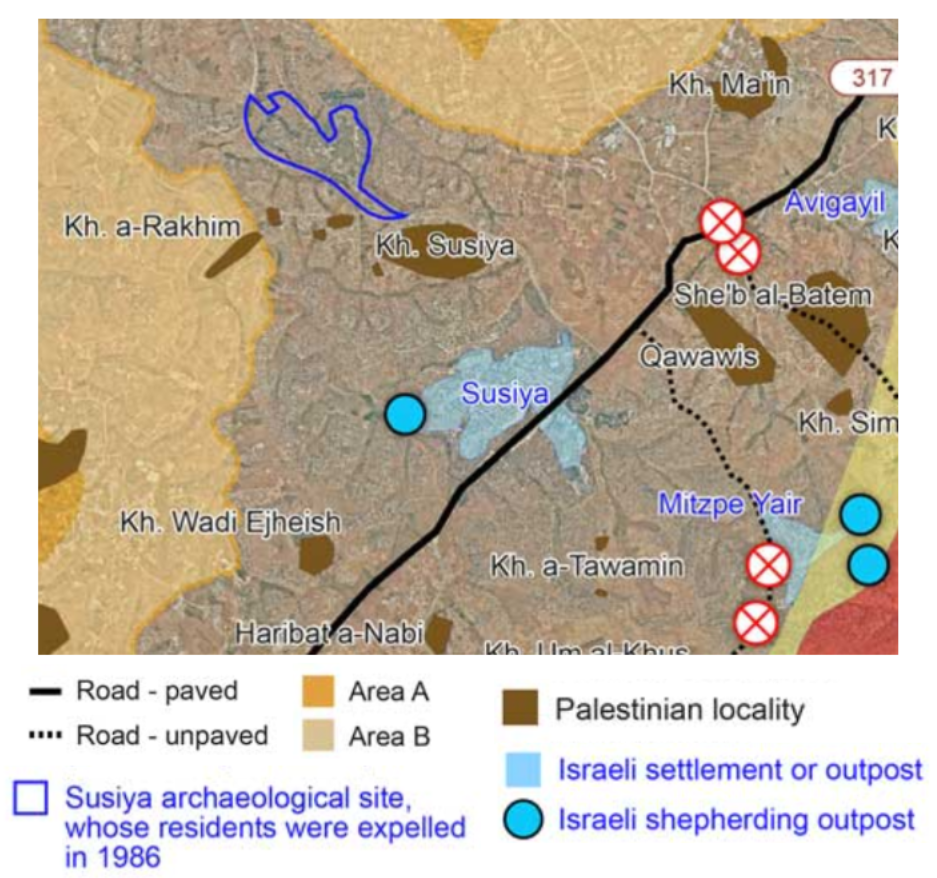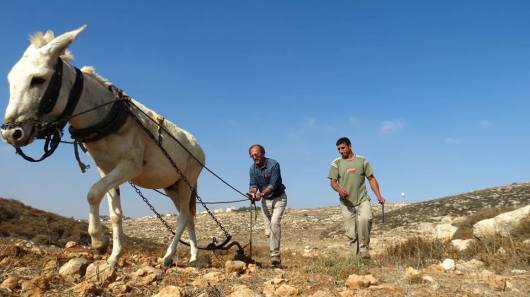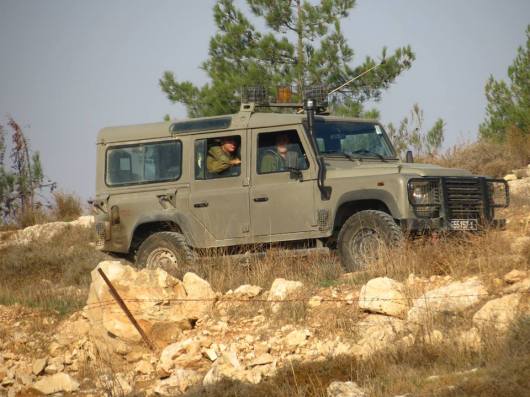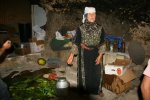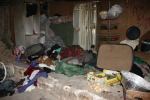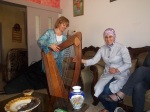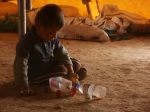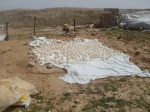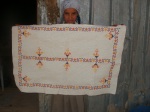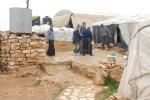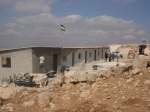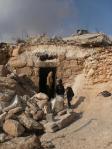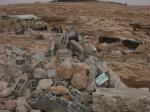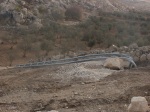Dear Friends and supporters,
Below is a story told by Sunita Staneslow on the new friendship and the start of musical cooperation between her, an Israeli harpist, and Yasmin (Ikhlas) Jebara, a young Palestinian poet and graduate student living under Occupation in the village of Salem near Nablus. In the shorter run, the connection between Sunita and Yasmin began at the Music Center in Salem, a center we have helped develop ever since the idea hatched in the mind of its founder (and current director) Jubeir Ishtayya a couple of years ago .
In the longer run, the story of Sunita and Yasmin is deeply connected with the story of our relationships with Yasmin and her family since the murder of her father almost eight years ago. This story and its dramatic twists of pain and hope, suffering and joy, despair and perseverance, and above all — friendship — is told below, after Sunita’s account, by Erella, as translated by our fellow activist Tal Haran.
Ehud Krinis, Villages Group
———————————-
The Story of Yasmin’s Harp,
Sunita Staneslow, 28th April 2012
I first met Yasmin last autumn when I visited the Salem Music Program with my harp to explore the possibility of a workshop with a visiting jazz harpist. Our guest harpist at the First Israeli Harp Festival, Park Stickney, wanted to work with Palestinian musicians during his trip. A seminar was organized for the Music Center several weeks later. It was then that Yasmin told me that she would like to learn to play the harp. She fell in love with the sound. “It sounds like water—like the sound of the sea!”
Harps can be expensive; there are no harps in Palestine (that I know of) and no teachers nearby. But, the seed was planted for Yasmin’s wish.
Park Stickney is one of the worlds’ most innovative harpists and he divides his time between New York City and Switzerland. Park is also brilliant at improvising and his workshop at the Salem Music Center started with a jam session between Park and the instructors. Park later told me that it was the best way for musicians to introduce themselves and find a common ‘language’. Yasmin was the primary translator for the class, and Park taught the kids to play a jazz tune. It was amazing to see the kids learn a classic American jazz tune using their voices, oud, violins, drums, and keyboards.
Park Stickney played on my large classical harp and we gave Yasmin a chance to sit behind the harp and glide her fingers up and down the strings. Yasmin reminded me that she would love to learn to play the harp. I told her that I would help her get a harp and teach her, not knowing how we would ever find the money to buy her a harp.
My husband, Fred Schlomka was certain that if we tapped into our mailing lists and sent out a request for contributions, we really could buy a harp for Yasmin. I am a professional harpist and tour in North America several times a year, and am part of the international harp community. Fred, through his company, Green Olive Tours, has contacts around the world of people interested in helping to bring peace and justice to the Middle East. We sent out a request with a beautiful photo of Yasmin at the harp. At first, money came in from harpists, friends and family in amounts of$15-100. The Colorado Harp Society pooled money and sent a check for $300. But, it was a couple from England who were so taken with Yasmin’s photo that they sent 11,000 shekels to buy the harp immediately. In total, over 40 people contributed towards Yasmin’s dream to learn the harp and welcomed Yasmin into the international harp family.
On Saturday, the 28th of April, I drove from Kfar Saba to meet with Ehud and other members of the Villages Group, and present Yasmin with her harp. The harp is made of wood, has 34 strings and is similar to the style of a Celtic folk harp. Several hundred years ago, there was a tradition in Ireland of blind harp players that travelled across Ireland on horseback to perform to the wealthy landlords. The most celebrated of these blind harp players was Turlough O’Carolan. Many of his beautiful melodies have become standards in the harp repertoire.
In the harp tradition, we have this connection between making beautiful music and being blind, although the modern harp is designed for those who can see the patterns made by the different colored strings. It isn’t like piano, where you feel the pattern of the notes between the different size and shape of the keys. So, for Yasmin, I glued beautiful stickers in the shape of jewels to mark the different colored strings.
There is another complication with the harp. Each string can be more than one tone, and there are levers that shorten the strings by half a step in order to change keys. Small bands were placed on the levers so Yasmin could feel the difference between them.
Our first lesson was spent learning how to make sense of how the harp is organized. Yasmin learned how to tune the harp, how to move the semi-tone levers and learn all the names of the strings. I was impressed with how quickly she understood. Her first assignment is to explore the harp and compose a short piece. She wants to play music that sounds like the sea in the key of C!
It takes me about an hour to drive from my home near Tel Aviv to Yasmin’s house in Salem. I cross through a checkpoint from Israel to the Palestinian Territories and drive alone on a road that most Israelis would never dream of driving on without an armored car. But, it would be impossible for Yasmin to get a permit from the Israeli army to take lessons in my home, so that is not an option. This is an exciting opportunity for me to ‘cross the veil’ into Palestine and develop a friendship with an amazing young woman.
I plan to teach Yasmin every other week. Together, we will work on melodies develop our own arrangements. I will teach Yasmin any melody she loves from my international repertoire, and she will teach me melodies from her tradition. This will be a musical journey that we will explore together and learn from each other. The harp is not a Middle Eastern instrument and the word for a harp in Arabic is either an adaptation of the English harp (harb) or Hebrew Nevel (nebel). Yasmin may be the first Palestinian to have a harp, and certainly the first one who is blind.
We spoke of dreams for the future when Yasmin can teach other Palestinian students to play the harp, perhaps even in the Barenboim Center in Ramallah. Someone asked her if she ever imagined that she would really get a harp. Yasmin gave us a big smile and said, “I am a very optimistic person.”
Yasmin is interested in connecting with blind harp players around the world. She may travel to the USA in September and I will try and arrange meetings for her with other harp players. Her musical journey has begun!
Sunita Staneslow
http://www.sunitaharp.com
Tel: +972-(0)54-212-5159
Fax: +972-(0)9-777-0020
USA fax: 800-809-7913
Yasmin
Erella Dunayevsky (translated by Tal Haran)
I have been sitting for hours staring at the empty computer screen.
Walking the paths of this story is like pursuing a single trail that splits into many, each splitting again, like blood vessels. I know I mustn’t venture into this maze because my reader might get lost inside, and I also know that if I don’t, the blood of this story will not reach the heart of its readers.
Mid-morning. August. Hot.
Uri and I walk along a bumpy road. Holes yawn at us in spots where the asphalt is worn out and are filled with gravel and dirt and glass shards of bottles that someone may have hurled in anger.
This, more or less, is how most roads look in Salem village, 2004.
We’ve been walking the roads of this village for two years now, visiting homes and getting to know a growing number of the villagers. Every week the number of our friends grows in direct proportion to the number of victims of the Occupation’s violent hand. Every week sees more villagers who have heard of us, and get used to our presence simply because we show up, again and again – every week, almost.
Mid-morning. Saturday. October 2nd, 2004. Hot.
Uri and I climb a bumpy road. We are on our way to pay a condolence visit to the Jbara family. Abed, native of this village, our old friend, accompanies us.
Sael Jbara was murdered five days ago. He was murdered while crossing a smooth road, free of potholes. It, too, is bumpy, though. A road that discriminates. An apartheid road, as local jargon would have it.
Sael drove a cab that hardly sustained his family at times of closures and barriers. (Salem drivers could deliver their passengers only up to the many checkpoints closing in on the village and preventing their passage even to Nablus and the neighboring villages, let alone other regions in the West Bank).
Five days earlier, Sael drove passengers to Beit Furiq checkpoint, hoping that perhaps this time they would be allowed through to Beit Hassan, a village sprawled south of Salem beyond the apartheid road. The soldiers at the checkpoint would not let him through. Sael was determined to bring his passengers home and put some bread on his own family table. Like all the indigenous inhabitants of this area who know the lay of the land as closely as they know their mother, Sael found a dirt track bypassing the checkpoint. Three meters of an asphalt road separated Sael and his passengers from the rest of this ancient dirt track leading to Dajjan Valley and Beit Hassan. The road has not only been paved upon the village farm lands, it is also a road that only ‘the lords of the land’ are allowed to use. Experience has taught Sael that if the soldiers catch him, they would force him back to the village (with or without getting beaten, depending on the soldier), or detain him for interrogation.
Sael took the risk and didn’t know that a settler from Itamar would take his life.
While crossing the road, Sael was shot in his heart, point blank.
The world of his wife and six children blacked out. The world of his two blind children was doubly darkened, for their daddy had promised to do everything to brighten their eyes and souls.
Saturday. Mid-morning. Hot.
Uri and I drag ourselves with Abed along the village’s bumpy road, the one with the torn asphalt, going to pay a condolence visit to the Jbara family.
Luckily my identity does not include nationality, religion, state and other characteristics normally expressing one’s identity. (One had better not confuse identity with its manifestations). I am thus exempt of guilt feelings and shame for one of my own nation having perpetrated this murder. My heart is free to meet the full power of pain over the loss of life, free to look directly at the poisonous fruit of blind souls who seek their remedy in ideologies of hatred and pettiness, free to feel the paralyzing pain of helplessness.
As I make room for this difficult encounter and pray that they themselves will not regard me as one who has come to apologize for her fellow nationals, we arrive at the bereaved home.
Vines shade the mourning area in the yard. A few people are now seated inside. None of them is familiar to us.
We are invited to sit down. We gingerly accept the invitation.
I sit in a chair next to Yasmin, Uri sits next to Mohammad.
The eyes of the seeing see the eyes of the blind.
Yasmin sits upright, her head slightly bowed. Her face is soft and lovely. And I, next to her, take a long look at her. I see that her blind eyes see a lot.
Some years later, I will be writing to her: “… Dear Yasmin, I know that your vision is deep and focused. Much more precise than many people whose eyes see but are in fact totally blind. The ability to see starts with the heart…”
But now we are in the mourning tent.
Mohammad, his body larger than his twelve-years of age would indicate, sits withdrawn. Uri speaks with him in Arabic.
“My name is Erella” I say to Yasmin, in Arabic as well.
“My name is Yasmin” she answers me in English.
“I am with you in your pain” I continue in English.
“I will not be able to go on living”, she answers. “Father was everything to me”. Silence.
“Hope, too”, she adds.
I place my hand on hers and say that this is how one feels at first. That it’s natural. It’s permitted. When my father died I was nine-years old and I thought life was over forever. Somehow I even wanted it to be so.
“When was that?” she asks, wishing to know me by touching my face.
“A long time ago”, I answer, directing her hand.
“How old are you?” she asks, sailing along my face somewhat hesitantly.
“Fifty-seven”.
“Your voice is young and your skin smooth, I thought you are twenty.”
“And you?” I asked.
“I’m seventeen. I have another year until I graduate high school. But now I don’t know what will happen.”
I hugged her. I whispered to her that after mourning, one can choose to live again. That life wants us to live it.
Nearly six years later, when we leaf back through the pages of this first meeting, Yasmin will remind me that I told her also that in order to live she should be independent and free, and that a higher education will be of great help to her. She will remind me that a week later we came to visit once more and I brought her a jasmine plant. I told her to plant it in her garden, so it would remind her of life.
She suggests I open my story as follows:
“Ten days after the mourning, a child of love was born named Yasmin. She was born of the Jasmine planted in her garden and blooming to this day”.
Since that condolence visit, the Jbara family entered our circle of friends.
Yasmin graduated high school and matriculated.
That year we helped her and Mohammad fulfill their father’s dream – bring them into Israel for a medical examination by a senior eye expert.
It was easy to set up the medical examination but hard to obtain their permits to enter Israel, for after their father was murdered, the children and their mother were black-listed, entry-prevented. This is the status assigned a Palestinian injured by a soldier or settler, and all of his family relations down to the tenth generation of descendants – even if the injury is lethal.
Anticipation was great, hearts trembled. On a rainy winter day Yasmin and Mohammad, escorted by Muna, their mother, made their way to Tel Hashomer Hospital. Uri and Edna drove them, supporting, escorting them.
The doctor examined them. Slowly, thoroughly. Finally, he gave his verdict, delicately, painfully: “They will never see”.
Heavy-hearted Mohammad and Yasmin were cheered a bit when Uri and Edna took them to the beach. It was their first time ever to see the sea. Or rather hear its roar, taste it, feel its water.
Salty sea drops blown by a strong winter wind dripped over the wounds of their heart and gave them a moment of respite.
They would return to this sea. At a more southerly beach, in the summer, in days that were not yet born.
In the meantime, another summer.
It’s hot.
Again we drag ourselves along the bumpy road to the Jbara home. This time we tell them the State has brought the murderer to trial. An exceptional event in the life of the nation. For a moment it seems justice might be done. David, present at the court sessions, learns all the details and updates the family.
Muna is taken up with her mourning and raising her children. She is grateful to David for what he is doing.
It is important for the family that the murderer be punished for what he had done. Not that any of them – neither old nor young – numb their pain with thoughts of vengeance. And still, the thought of such murderers behind bars could instill a measure of physical and emotional security. After all, the family knows that their occupier is a progressive democratic state run by law as other nations in this world, even enlightened occupiers.
In this summer of 2005 the verdict has been issued at the murderer’s trial: manslaughter. But the judge sent the defendant home until the sentence is issued. The State prosecutor poses no objection. The defendant does what he had been enabled to do – he runs away. No state institution – not a living soul – really takes the trouble to look for him. The seal is set.
Sael was murdered yet again. Once by Yehoshua Elitzur, a German convert to Judaism from Itamar settlement, and again by the justice system of the State of Israel.
The family mourns again. We stay with their pain, contain it, and together with them lick again the seething wounds of helplessness.
At this time, Yasmin is getting ready for her first year at university.
She spent her first ten years of school at a special school for the blind in Ramallah. Her last two years of high school have been successfully accomplished at the normal high school in her village.
But university is an altogether different matter.
In spite of her full fluency in Braille, in spite of her talent and the stable part of her personality that enables her to recover time and again, Yasmin is anxious before starting off her academic studies. A small tape recorder which we give her for the lectures she will be attending helps a bit to assuage her fears. But this does not begin to meet the needs for independent movement. This has not been taught at the special school for the blind.
For two long years Yasmin grapples with her need to be escorted on her daily journey from Salem to Nablus and back, and in the large university campus itself. She learns to transform the shackles of constant debt to her helpers into the liberating state of gratitude.
When Yasmin learns, at the beginning of her first semester, that most of the professors mail their lectures to the students electronically, we engage in finding a special computer for her with a particular program for the visually impaired.
As always, this time, too, we have gambled. The challenge is met by a Jewish Israeli citizen who donates money to buy the computer.
Saturday, early summer 2006. It’s hot.
After walking up the bumpy road, full of potholes, we gather at the Jbara home – Noa and her partner Ehud, who look to the professional aspect of the computer; Qassem, computer-store owner from Nablus, where the computer was purchased. He has never before been in Salem, four minutes ride from his shop; Fadi, the blind installment technician (Palestinian citizen of Israel from Sha’ab village in the Galilee); Yasmin and her family and ourselves, of course.
We all crowd into the small living room to celebrate another phase in Yasmin’s coping with her boundaries.
Silence fills the room. Some of the people deliver a few modest and celebratory words on this occasion. So does Yasmin. Then silence wraps us again.
A Palestinian from Nablus, Jews from Israel, a Palestinian from Israel (arriving on the bumpy road, without the potholes, receiving a special permit to enter through the military checkpoint), visit a Palestinian home in Salem. They all sit in one room from which the curtain has momentarily been lifted. For a borrowed moment they witness the order of Creation as nakedly self-evident as when it was eternally born – serving each other with the measure of love needed to heal pain. Love manifesting itself in various modes of one identity – a human at the shrine of the deity.
Muna serves heaps of stuffed vine leaves. We eat, laugh, weep, chat, take leave. Each of us goes home, having to cross the army checkpoint again on our way out (no other possibility when the order of things loses its obviousness).
Mohammad, who, until now, has attended a special school for the blind in Jenin, is transferred to a similar school in Bethlehem. Yasmin is finishing her sophomore year at Al Najah, and is moving to Nablus to live at a special hostel for blind students, going home on weekends. Muna cannot resist the pressures of her family and neighbors and the computer, waiting for Yasmin at home, becomes everyone’s business and is in a state of disrepair. Our attempts to convince Muna to move the computer to the hostel are resisted, We don’t understand the reason for this. Nor do we understand why Yasmin, who usually knows how to hold her ground, does not veto this. But we do realize there are things beyond our comprehension.
Perhaps these are social, family or neighborhood codes unfamiliar to us. Whenever I touch the thin line separating that which is in my hands from that which isn’t, I am deeply saddened. It’s an existential sadness that opens its arms to me, and I surrender to it until the pain eases.
It happens this time, too…
Muna is a woman of valour. A brave navigator in stormy seas. Sometimes in a tsunami. Only occasionally, here and there, are the skies are partly cloudy or clear.
As the family now has no breadwinner, Muna makes good use of her wisdom and the special knowledge that the impoverished use in order not to drown. With the meager funds that the Palestinian Authority allots bereaved families, and the meager help of her extended family, she somehow navigates the ship. Her nights unravel her worry. How will she ensure the future of her children – Suhad, the eldest, not yet done with her technology studies at Nablus’ Hajawi College; Yasmin still faces another three years, almost, until she completes her B.A. in English; Sharif, already seventeen, does not want to continue his schooling and has been looking for work – so far in vain; Mohammad has yet another three years until matriculation. Then he plans to go to the university in order to acquire a profession he can qualify for with his blindness; Beautiful Assala, just twelve, already knows she will be a lawyer when she grows up; Yahya, the youngest, is still a long way from maturity and independence.
In July 2007 the family wins its civil suit, pressed against the State by an attorney. The State of Israel pays them damages which can never be enough to hide the naked obscenity, but still provide Muna some relief.
The family breathes more freely now. It shows in Suhad’s shy smile, completing her studies; in the walls of the home, freshly painted by Sharif; in Mohammad’s daring to return home and begin, for the first time ever, a year of normal high school; in Asala, an outstanding student, and in Yahya who now enters adolescence.
In the meantime, without any emotional privileges, Yasmin ripens into young womanhood. Along with her ripen her poems.
A love crisis slashes her spirit in late summer 2009. Yasmin recites for us a poem born of this crisis. (As always, since childhood, writing, her openness and her ability to share help her rise all the stronger from the pitfalls on her way).
“In our silent, narrow street
I followed his footsteps…
In a dark and cloudy mood
Moon, sun, stars
Look so bright,
Confidence… courage… Oh fear
Not even a teardrop in heaven’s eyes
Only a spark of hope so close
That even escape will not defeat”…
——————————————–
January 2010. Cold. Rainy.
Danny, Ehud and I navigate the bumpy, potholed road, now muddy too, trying not to trip. We walk to Yasmin’s house, to give her a private party of our own, celebrating her graduation as a Bachelor of Arts in English.
In honor of the occasion, Yasmin writes:
“Have you ever felt
What it is like to be a person
Soon graduating,
Standing at the university gates,
Facing the threshold of one’s life?
People coming to congratulate me
Light within me a spark of hope.
Like a king who has won a kingdom
I am a woman loved by her fate…”
A few weeks later Yasmin calls us, profoundly depressed. No school. No Nablus. No hostel. No friends. Yasmin is home again. This secure nest no longer fits her size. Yasmin wants to break out, spread her wings and take off – away from the arms of her mother and little village. She wants independence, she wants to own herself. But she has no mobility skills and no job. Muna is resourceful and tries to use this time to enable Yasmin more independence in performing household chores – cooking, laundry, cleaning… Yasmin cooperates but, at the same time, sinks into a deep black pit.
Ehud suggests we mobilize our friends abroad, especially in England, to call her on the phone and keep her busy conversing and exercising her English, and especially to give her a sense of contact with the ‘world out there’.
Dear Nancy from faraway Edinburgh takes charge. With so much attention and empathy she keeps calling. At first because we asked her to. Then, because Yasmin’s personality fascinates her, invites her to love. What a gift Yasmin is. If only she could trust her strength, rely on the beauty of her garden.
“Jasmine blooms in winter”, I remind her in our frequent support calls and visits.
Nancy has managed to arouse the interest of her friends in Yasmin’s story. They have transformed their obvious empathy into donations for purchasing a new computer for Yasmin (laptop, this time), including a modern program for the blind. The computer that was out of order will now be repaired, and will serve Mohammad in his next year of studies, his matriculation time. (Our many attempts to revive the computer with Tel Avivian knowhow were futile. Recently the solution was found in Nablus. Masters of improvisation).
On a Thursday in February, 2010, as on every normal Thursday (if there is such a thing) we are in the South Hebron Hills. While our friends from Umm Al Kheir show us the ruined fence in their farmland (the tracks of its destroyer lead to Carmel, the nearby Jewish settlement), my cell phone rings. It is Nancy from Edinburgh calling. She joyously tells me Yasmin has been summoned for a work interview in Ramallah, by an NGO called “Stars of Hope”. My spirit cannot share her joy. One part of it is still caught in the broken fragment of that ruined fence, and the other part is twice-shocked – first, realizing that news of Yasmin reaches me via Edinburgh, and second – wondering how anyone in “Eastern Palestine” even knows of some Yasmin in Salem village looking for work. This is the “gamble” that has reached some haven and has been picked up.
The story of Yasmin, which we have made public by email several months earlier in an attempt to help her in her despair, has reached the Ramallah NGO through one of its workers whom Ehud met at one of the Jewish-Palestinian conferences we attend occasionally. At her request, Ehud added her address to the list of our contacts.
Between winter and spring, in March 2010, Yasmin begins her training in the Palestinian society for the advancement of disabled Palestinian women – “Stars of Hope”.
She goes to live in Ramallah, is nearly independent and is earning her own livelihood for the first time in her life. Yasmin’s joy soars and is blessedly gathered into the lap of a soft, embracing heaven. Then her rage crashes against a tight, parched ground in a painful emergency landing. She is fired after one month.
Her insult is as deep as the bleeding pain of her ripening understanding of the existence of elements that interfere with her fate, which she has no way of directing or affecting.
She is home again, restoring the debris of her life. The school for the blind in Ramallah has notified her that she will not be appointed teacher in the coming school year. Yasmin realizes she must expand her employment opportunities, and decides to proceed with her graduate studies in English, specializing in translation.
This will happen only in October, and in the meantime – a long and exhausting summer lies ahead.
Summer 2010. Hot. Humid.
I climb up the bumpy potholed road to the Jbara home.
Between tea and stuffed vine leaves (that Muna prepares, knowing I like them), Yasmin sows an idea as old as our acquaintance: “I would so much love to visit you at your home”, she says.
Typing her family data on my keyboard, a slight shadow creeps into my mind. I try to ignore it but it grows insistent until there is no escaping it. I feel it hammering in my head: “They will not be issued permits”, “they will not be struck off the black list”, “there’s no chance”, “Occupation never changes”. Then I hear my heart: “No doubt they’ve been taken off the black list”, “even brutality has its limits”, “it’s been six years”, “after all, perhaps the regime is building trust by making mobility lighter”. And again the hammers strike, again the heart speaks. Hammers… heart… The mail to Buma (our ‘permit’ friend) is on its way. Two weeks go by. Buma calls. The answer has arrived. No permits. All this family’s children are ‘prevented’ (denied entry into Israel-proper) by the Shabak secret police, formally known as the General Security Services.
No hammers, no heart-voice. Only the blunt ache of helplessness spreads throughout my body and what remains of my sane mind. Nothing has changed. Nothing changes. Six years are like the forty-three years of Occupation. My heart goes crazy, my mind leaps out of itself. I cry.
In my mind’s eye I already see myself arriving at Salem this weekend, on the bad road without the potholes, how I’ll climb on foot to their home on the bad road with the potholes, and tell them, face to face, that they have no permit to be free.
Buma suggests suspending the answer. He has filed an appeal, requesting permits once again for the family in spite of their being blacklisted. “You know how it is”, he says. “This whole business is arbitrary. Perhaps the second request will be treated with a different arbitrariness”. And indeed a different arbitrariness is applied.
“Thank you for the right to freedom that loses its freedom by being granted, let alone granted by the mean insolence of arbitrariness that leaves not the slightest doubt who is just and who evil…” my soul wants to cry out. I transform the outcry into a wish: “I wish for you, the blind, that one day,” I say in my heart, “your eyes will open to see”… my soul, tamed to transform, relents, tired but grateful for this wish that has transformed a raging fire into the light that enables me to tell what is in my hands from what isn’t. Freedom itself is embodied in this aching acknowledgement. Freedom that can neither be granted nor robbed, for freedom of the heart can never be dependent on anything. When I do the deeds that bring me in the way of blunted hearts and other damages of blindness,
I do them of my own free will. I use my fullest freedom when I choose to come in touch with the realms of suffering of the other one, and to be a true healer. After all, I could choose not to be present on such occasions.
Summer. August. Hot. Humid.
The Jbara family walks the narrow paths of Kibbutz Shoval. Danny, Ehud and I lead them to our home.
In a little while we’ll drive to the beach. Zikim beach. They will be sitting in the waves that lick the shore, abandon their bodies to the water’s warm caress, taste salt, laugh with their whole being as they’ve never done before, at the thrill of a first encounter.
Only Yasmin and Mohammad will remember that their first was five years ago, in winter after a medical examination. The rest will have no memory. The first time on the beach that is no further from their home than it is from mine. We will look at them lovingly. Our souls will laugh and cry, and so will theirs, when the sun will set into a hazy horizon, patient and soft, reminding us of the order of Creation, self-evident.
Erella Dunayevsky, Villages Group, May 2012. translated by Tal Haran.

